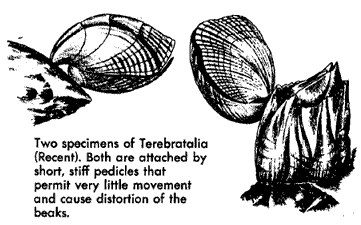| Rhynchonelliformea | ||
| Brachiopoda | Terebratulida |
| Metazoa | |||
Terebratulids are one of the only two living orders of articulate brachiopods, the other being the Rhynchonellida. They are bulbous in shape, commonly circular or ovoid in outline, and have a simple calcareous loop supporting the lophophore. Terebratulids are also distinguished by a very short hinge line, and the shell is punctate in microstructure. Surface ornamentation is variable, with a single species sometimes showing both smooth-shelled and ribbed forms. There is a circular pedicle opening, or foramen, located in the beak. The characteristic shape of terebratulids resembles that of ancient oil lamps, and thus the common name for brachiopods is "lamp-shells".

Terebratulid success may be due to their unique adaptation of transapical resorption. During ontogeny the fold in the deltidium becomes relatively larger, which allows enlargement of the pedicle with increasing size. This allowed larger species to have much strong attachment to the substrate
Terebratulids may have evolved from Atrypids during the early or Middle Silurian. Early genera were almost circular to elongate-oval, with smooth or finely costate shells. During the Cretaceous and Tertiary periods, many shells became coarsely plicate. Terebratulids are important today, especially on the Pacific coast of North America. Despite their antiquity, living terebratulids are advanced organisms, able to out-perform molluscan bivalves in filter feeding efficiency under certain conditions. Some species inhabit rocky shores, though others prefer quiet, and cold deep water environments.
Stryingocephaloidea (Early Devonian-Late Permian)
Dielasmatoidea (Early Devonian-Late Jurassic)
Cryptonelloidea (Early Devonian-Late Permian)
Terebratuloidea (Early Triassic-Recent)
Dyscoloidea (Early Jurassic-Recent)
Cancellothyroidea (Early Jurassic-Recent)
Loboidothyridoidea (Early Jurassic-Late Cretaceous)
Terebratelloidea (Paleocene-Recent)
Zeillerioidea (Early Triassic-Recent)
Kingenoidea (Triassic-Recent)
Laqueoidea (Cretaceous-Recent)
Megathyridoidea (Early Cretaceous-Recent)
Bouchardioidea (Cretaceous-Recent)
Kraussinoidea (Miocene-Recent)
Platidioidea (Late Cretaceous-Recent)
Gwynioidea (Jurassic-Recent)
Thecospiroidea (Early Triassic-Recent)
Thecideoidea (Early Triassic-Recent)
Classification from Classification des Brachiopoda (Lophophorata)
superfamilies from Treatise on Invertebrate Paleontology